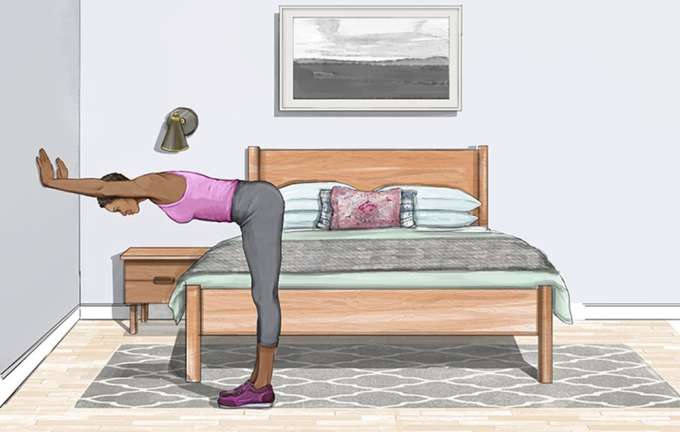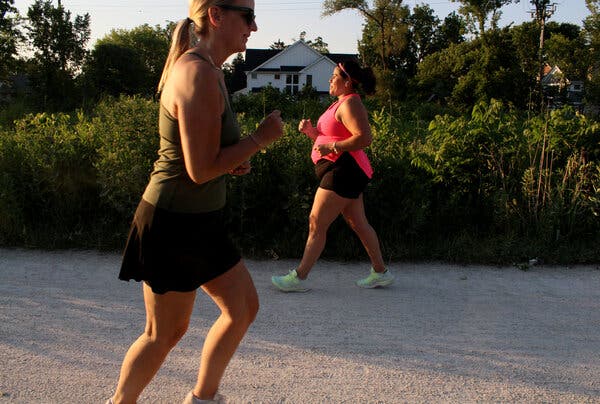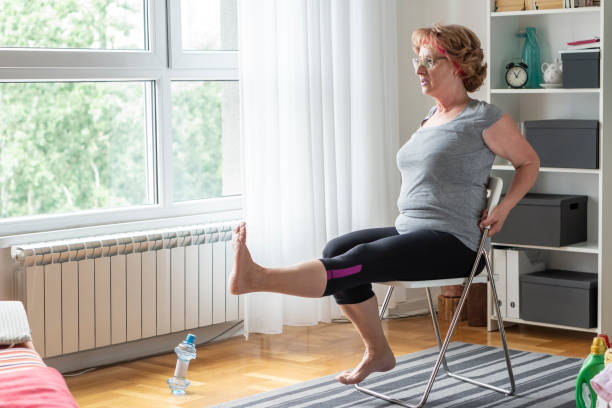physical activity alleviates chronic musculoskeletal pain Start where you are. use what you have. do what you can.
Explore your exercise options below:
Flexibility exercise
Stretching is of critical importance for FM patients. Flexibility exercises help loosen tight muscles, leading to decreased pain, muscle soreness, and stiffness. Mobility exercises help you increase your range of motion at the joint, allowing you to move more freely throughout the day. These exercises can help you extend your reach, bend with less pain, improve your posture, and lengthen your stride.
Check out our recommendations below:
Neck
How to:
1) Lean your head to the right side.
2) Gently use your right hand to get your head closer to your right shoulder.
3) Use your left arm to stabilize yourself.
4) Hold for 6 seconds then switch sides.

Shoulders
How to:
1) Take 2-3 feet away from the wall.
2) With your feet hip-width apart, plant your hands on the wall slightly above your head.
3) Look down and slightly push your chest down.
4) Hold for 10 seconds.
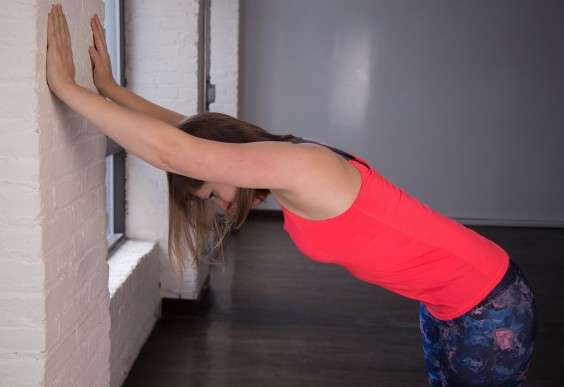
Legs
How to:
1) Sit at the edge of a chair.
2) Lean forward slowly and reach as far as you can without feeling pain.
3) Hold for 10 seconds.
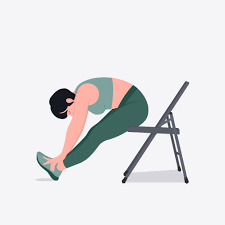
Aerobic activity
Overall, this is the most important form of exercise for patients with chronic pain, like FM. Rhythmic aerobic exercise improves your cardiovascular health by strengthening your heart and lungs. Additionally, it makes you less sensitive to pain. When exercising, remember to breathe rhythmically, hence “aerobic” or “with oxygen”. Maintaining your breath will allow you to go farther distances and go on for a longer time.
You may feel more muscle soreness at the beginning of exercise. If you have chronic musculoskeletal pain and feel moderate but tolerable pain due to movement, then take a break, rest, and continue to exercise at a lower intensity. If you start feeling intense and intolerable pain, stop the exercise session and start your muscle recovery process. Recover your muscles by staying hydrated, massaging or applying gentle heat to your muscles, and continuing light, gentle movements.
Aerobic activity helps individuals with FM by decreasing pain and fatigue, uplifting mood, and improving sleep quality. It also increases stamina and endurance, making it much easier to walk your dog, mow your lawn, or roam around the grocery store.
Check out our recommendations below:
What?
– Walking
– Biking
– Swimming
What to avoid:
High-impact exercises (ie. running, jogging, jumping rope)
How often?
The length of the session and number of sessions per week may vary from person-to-person and depend on your current fitness levels. For patients with FM the rule is: “Do as much as you can”.
For beginners, you may start with 5-10 minutes per day, 3-5 times per week. When you feel ready, patiently work yourself up to the recommended exercise guideline:
Total of 150 minutes/ week
Or 30 minutes/ day, 5 days/ week
You may also set a goal of walking daily. Most phones offer apps with free step trackers. Look at your current activity levels and try to gradually increase your step count. The more, the better!
How hard?
Low to moderate intensity.
Aerobic exercise causes your heart rate and breathing to quicken; you should exercise at an intensity that allows you to talk and carry on a conversation.
If you are looking for more of a challenge, you can build up the intensity by moving at a faster pace, shortening your rest times, or lengthening your exercise sessions when you feel ready.
You should always try to push yourself when you’re exercising, but it is important to learn your limits and gradually increase your activity levels.
Where?
Walk or bike around your neighborhood, at a local park, or go to a local gym. Getting outside when the weather is nice benefits your mood as well! If you have access to a pool, swimming is also a great way to increase your aerobic activity.
Strength training
For patients with pain, this is the most effective, but also most challenging form of exercise. Strength-training exercises condition your muscles and help support your joints. It’s important to maintain good form during strength training to avoid any injuries. After learning good form, try gradually increasing the difficulty. You can carry household items (ie. bottles of water), use resistance bands, handheld weights, and wrist or ankle weights to add resistance.
Check out our recommendations below. If you need guidance on how to perform the movement, click on the video link for a demonstration.
Upper body
Tennis ball grip
Equipment: tennis ball
How to:
1) Start with your hand open and fingers spread out. Balance the tennis ball at the center of your palms. Rest your arm on a flat surface.
2) Tightly squeeze a tennis ball in your hand. Hold it for 3 seconds.
3) Relax the squeeze slowly.
4) Extend your fingers out back into neutral position.
5) Repeat 12-15 times.
Challenge yourself:
– Hold the squeeze for 5 seconds.
– Control your relaxation from the squeeze and take
Upper body
Wall push up
Equipment: a wall
How to:
1) Stand up slightly farther than arm’s length away from the wall and your feet shoulder-width apart.
2) Lean forward and place your palms flat against the wall at shoulder height.
3) Slowly bend your elbows and lower your upper body towards the wall.
4) Push yourself back up slowly until your arms are straight.
5) Repeat 5-10 times.
Upper body
Bent arm raise
How to:
1) Hold your arms to the side at shoulder height with your palms facing forward and elbows bent at 90 degrees.
2) Slowly straighten your arms up. Hold this position for 1 second.
3) Slowly bring your arms down and back to shoulder height in a controlled manner.
4) Continue this sequence 3-6 times.
Challenge yourself:
– Hold a bottle of water in each hand.
*Caution: hold the can tight, and avoid dropping it.
Lower body
Sit to stand
Equipment: chair (stable, non-swiveling, with a backrest)
How to:
1) Sit down with your legs making a 90 degree angle.
2) Plant your feet on the ground, shoulder-width apart.
3) Put your hands on your hips.
4) Raise yourself up to a standing position in a controlled manner for 3 seconds.
5) Lower yourself back down to a sitting position in a controlled manner for 3 seconds.
6) Continue the sit to stand sequence 6-10 times.
Challenge yourself:
– Hold your arms straight in front of you, parallel to the ground or cross them against your chest.
Lower body
Leg raise
Equipment: chair (stable, non-swiveling, with a backrest)
How to:
1) Stand behind the chair. Hold the edge of the backrest with both hands. Plant your feet on the ground, shoulder-width apart.
2) Practice good posture: keep your back straight and your toes facing forward.
3) In a controlled manner, lift your right leg straight behind you then back to a neutral position. Then, lift your right leg on your right side then back to a neutral position. Keep your left (supporting) leg steady and slightly bent.
4) Repeat this motion but switch legs.
5) Continue this behind-neutral-side-neutral sequence 6-10 times.
Challenge yourself:
– Take 3-5 seconds to lift your leg behind you or to the side.
– Use ankle weight for more resistance.
Lower body
Standing heel and toe raise
How to:
1) Hold on to a stable object for balance. Plant your feet on the ground, shoulder-width apart.
2) Practice good posture: keep your back straight and your toes facing forward.
3) Slowly stand up on your tiptoes then your heel. Hold these positions for 2 seconds.
4) Continue this sequence 6- 10 times.
Challenge yourself:
– Hold the position for a longer time.
– Use ankle weight or carry a backpack with your hands for more resistance.
Aquatic exercise
Aquatic exercise is especially beneficial for individuals experiencing chronic pain in their joints and muscles. The water has a “buoyant effect”, which means that you will feel lighter submerged in water. This makes movement easier on your joints. The water also serves as a slight resistance and is a perfect place for low-impact exercises.
To avoid added muscle tightness, avoid cold water temperatures and find a pool with temperatures of 78 to 86 degrees Fahrenheit.
Check out our recommendations below. Click on the video link for more guidance.
full body
Stretch in water
1) Stand in water at chest level.
2) One-by-one stretch your arms up to the sky and legs towards the bottom of the pool.
3) Rotate your wrists and ankles clockwise the counter-clockwise underwater.
lower body
Scissor kicks
Equipment: kickboard
How to:
1) Rest both of your arms on the kickboard with your arms slightly bent. Use the kickboard to keep your body afloat.
2) Curl your fingers around the top edge of the kickboard.
3) Gently push off the ground to get your body in a horizontal position. Try to use your core muscles to stay up.
4) Like a pair of scissors, alternate your legs up and down repetitively to move forward. Point your feet and your ankles flexible.
5) Kick until you reach the other end of the pool. If you need to rest, simply stop, stand, and catch your breath. Continue kicking.
Upper/ full body
Arm raises
1) Stand in water at chest level.
2) Get into neutral position– feet flat on the bottom of the pool and feet width apart; hands on your side.
3) Raise your arms to your side then above your head then back down to your side. Keep your arms slightly bent.
4) Repeat this motion 3-5 times.
Challenge yourself:
– Do jumping jacks. Add the leg movement by gently pushing off the bottom of the pool and widening your stance. Then go back to neutral position. Keep your arms and legs slightly bent. Repeat 3-5 times.


